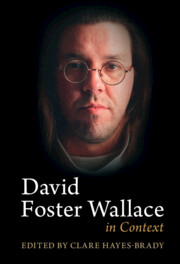Book contents
- David Foster Wallace in Context
- David Foster Wallace in Context
- Copyright page
- Contents
- Figures
- Contributors
- Acknowledgments
- Abbreviations
- Introduction
- Part I Contexts
- Part II Ideas
- Part III Bodies
- Part IV Systems
- Chapter 26 Infinite Jest as Opiate Fiction
- Chapter 27 David Foster Wallace and Racial Capitalism
- Chapter 28 Language and Self-Creation
- Chapter 29 Very Old Land
- Chapter 30 David Foster Wallace’s Ecologies
- Chapter 31 “I Could, If You’d Let Me, Talk and Talk”
- Chapter 32 David and Dutch
- Chapter 33 David Foster Wallace and Publishing
- Chapter 34 Author Here, There and Everywhere
- Works by David Foster Wallace
- Bibliography of Secondary Sources
- Index
Chapter 28 - Language and Self-Creation
David Foster Wallace’s Many Ways of Sounding American
from Part IV - Systems
Published online by Cambridge University Press: 18 November 2022
- David Foster Wallace in Context
- David Foster Wallace in Context
- Copyright page
- Contents
- Figures
- Contributors
- Acknowledgments
- Abbreviations
- Introduction
- Part I Contexts
- Part II Ideas
- Part III Bodies
- Part IV Systems
- Chapter 26 Infinite Jest as Opiate Fiction
- Chapter 27 David Foster Wallace and Racial Capitalism
- Chapter 28 Language and Self-Creation
- Chapter 29 Very Old Land
- Chapter 30 David Foster Wallace’s Ecologies
- Chapter 31 “I Could, If You’d Let Me, Talk and Talk”
- Chapter 32 David and Dutch
- Chapter 33 David Foster Wallace and Publishing
- Chapter 34 Author Here, There and Everywhere
- Works by David Foster Wallace
- Bibliography of Secondary Sources
- Index
Summary
This chapter considers Wallace’s use of individual language and narrative as a means for self-creation, from the heavily be-nicknamed LaVache in Broom, who molds his vocabulary to evade communication with his family, to the impersonal marketing argots of commercial focus groups, by way of the community-forming ritual recitations of AA. The chapter highlights Wallace’s extraordinarily prolific (though not uniformly successful) mimesis of vernacular, noting some of the more interesting failures of his career in this respect, including “Solomon Silverfish” and sections of Infinite Jest. This chapter elucidates the operation of language, both monologic and dialogic, as key to Wallace’s aesthetic project and as a central weapon in his ethical strategy for overcoming solipsism, involving sincerity, cooperation and absolute faith in the other.
- Type
- Chapter
- Information
- David Foster Wallace in Context , pp. 303 - 313Publisher: Cambridge University PressPrint publication year: 2022

